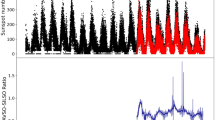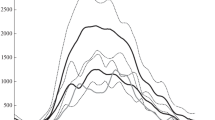Abstract
The current 24th solar activity cycle started in 2008 and continuing to the present is anomalous in comparison with previous cycles. Its unusual properties include a low sunspot number R z for a long time, a weak interplanetary magnetic field, a weak polar photospheric field in the Sun, and others. Beginning in 1000 to the present, five prolonged solar activity minima took place. These minima occurred in time intervals, when the distance between the center of mass of the solar system and the Sun center changed several times from maximum to minimum values for 40–70 years. Since the beginning of the new millennium, exactly such a period started and it can be assumed that we entered a new prolonged minimum which will last for several decades. In the current 24th and subsequent 2–3 solar activity cycles, annual average sunspot numbers will be low, R zmax ≤ (50–70).
Similar content being viewed by others
References
D. V. Vogt and K. H. Shatten, Solar Physics 179, 189 (1998).
http://sidc.oma.be/index.php3; http://www.swpc.noaa.gov/SolarCycle/index.html
D. J. Shove, J. Geophys. Res. 60, 127 (1955).
J. A. Eddy, Scientific American 236(5), 80 (1977).
Y. Stozhkov, “Modulation of the Cosmic Ray Flux in the Beginning of the 24-th Solar Activity Cycle,” in Proceedings of the International Symposium FORGES 2008, Yerevan, Armenia (Yerevan Univ., Yerevan, 2009), p. 12.
Yu. I. Stozhkov, V. I. Ermakov, and V. P. Okhlopkov, “Solar Activity in the Present and Near Future,” in Proceedings of theWorking Conference “Activity Cycles in the Sun and Stars,” Sternberg Astronomical Institute, Moscow State University, Moscow, December 2009 (St.Petersburg, 2009), p. 263.
V. P. Okhlopkov and Yu. I. Stozhkov, Izv. Ross. Akad. Nauk Ser. Fiz. 75, 911 (2011) [Bull. Russ. Acad. Sci. Phys. 75, 860 (2011)].
B. P. Komitov and V. I. Kaftan, Geomagnetizm i Aeronomiya 43, 592 (2003) [Geomagn. Aeron. 43, 553 (2003)].
V. I. Kozlov, Nauka i Tekhnika v Yakutii, No. 1(10), 51 (2006).
ftp://ftp.ncdc.noaa.gov/pub/data/anomalies/monthly.land?ocean.90S.90N.df1901-2000mean.dat
V. I. Ermakov, V. P. Okhlopkov, and Yu. I. Stozhkov, Kratkie Soobshcheniya po Fizike FIAN, No. 3, 41 (2006) [Bulletin of the Lebedev Physics Institute, No. 3, 32 (2006)].
Author information
Authors and Affiliations
Corresponding author
Additional information
Original Russian Text © Yu.I. Stozhkov, V.P. Okhlopkov, 2013, published in Kratkie Soobshcheniya po Fizike, 2013, Vol. 40, No. 2, pp. 3–12.
About this article
Cite this article
Stozhkov, Y.I., Okhlopkov, V.P. On the new prolonged solar activity minimum. Bull. Lebedev Phys. Inst. 40, 27–33 (2013). https://doi.org/10.3103/S1068335613020012
Received:
Published:
Issue Date:
DOI: https://doi.org/10.3103/S1068335613020012




